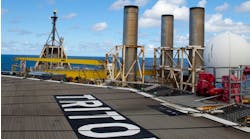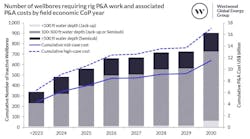View Article as Single page
Phase IX
At the completion of Phase VIII the system had effectively been expanded beyond its practical design limit, with sensors needing to be "disconnected" to maintain operation using a single power channel on both the Simian and Sapphire hubs. Also, the earlier Phase IV expansion had exhausted all available capacity of the shore-based Aker Solutions control system. To further expand the system to accommodate potentially another 16 wells, nine HIPPS, and one manifold, all distributed across the Simian, Scarab/Saffron, and Sapphire areas, a significant reassessment and system upgrade would be needed.
The conceptual stage examined options for expanding the control system, including a control buoy; high voltage power supply (< 1kV AC); a new control system; and a new umbilical to the platform or directly to shore.
A control buoy would provide the significant benefit of a relatively short length of electrical umbilical by locating the buoy directly above the system tie-in point. This would minimize both the cost and voltage drop of the main umbilical. However, the cost of a control buoy system would be substantial, and interfacing this with the existing control system would require significant modifications to existing hardware/software interfaces. Further, there was the question of reliable communications, either over a satellite link or an additional, dedicated communication umbilical to shore.
The introduction of a high voltage – greater than 1kV AC – three-phase system represented a significant technical change to the existing philosophy and was deemed too great a risk in terms of integration with existing assets and technical complexity. Therefore, a single-phase solution remains the best case for power transmission.
A new shore-based umbilical would be costly due to the long offset required, and would also require a new shore-based control system. In addition, it potentially "splits" the control of an area across two master control stations involving extra interfacing, and would not resolve the power limitation of the existing system.
A new umbilical from the Simian controls platform would allow the full expansion of Phase IX by providing the flexibility to balance existing system loading and to use the EPU channels originally dedicated to Saurus, which remain unused following a power cable failure on Sapphire. Maintaining the original supply voltages also would allow the provision of inter-field umbilicals to better distribute power between the fields, with a large cross-section to provide capacity for further expansion.
With all options, the costs are significant. However, the introduction of a new main umbilical from the controls platform is the route taken for Phase IX due to the easier integration with existing systems and more straightforward future expansion.
The current Phase IXa, which came onstream in summer 2014 and which is still under construction, involves adding nine wells, six HIPPS, and one manifold to the Simian and Scarab, and Sapphire areas. The campaign includes installation of a J-tube and associated topsides equipment, upgrading the power transformers, and installing a new umbilical to the Scarab area. From there, infield umbilicals will distribute additional power to the Sapphire and Simian hubs to support the new wells, HIPPS, and manifolds, along with the existing equipment. The system is designed to be suitable for the IXb campaign and beyond, with potential for further expansion of the WDDM subsea architecture.
The onshore plant can process 2 MMcf/d of gas, and there will always be a driver to maintain this limit. Therefore, studies are underway to connect the Libra and Taurus fields, part of the BP West Nile Delta concession, to the current pipeline network. This will enable the onshore plant to maintain plateau production and also allow these fields to be brought onstream without having to build additional onshore capacity.
From a control system perspective, these fields will require a complete new control system, which, after conceptual study, will be from the platform. Modifications to the platform will increase not only the control system capacity, but also the chemical injection capability as an additional J‐tube being installed to allow a dedicated umbilical to support the Libra‐Taurus development, and possibly more.
Acknowledgments
Based on a paper presented at the Deep Offshore Technology International Conference & Exhibition held in Aberdeen, Scotland, October 14-16, 2014.


